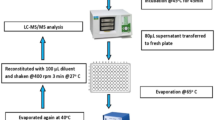Abstract
The quantitative analysis of amino acids (AAs) in single dry blood spot (DBS) samples is an important issue for metabolic diseases as a second-tier test in newborn screening. An analytical method for quantifying underivatized AAs in DBS was developed by using liquid chromatography coupled with tandem mass spectrometry (LC–MS/MS). The sample preparation in this method is simple and ion-pairing agent is not used in the mobile phase that could avoid ion suppression, which happens in mass spectrometry and avoids damage to the column. Through chromatographic separation, some isomeric compounds could be identified and quantified, which cannot be solved through only appropriate multiple reactions monitoring transitions by MS/MS. The concentrations of the different AAs were determined using non-deuterated internal standard. All calibration curves showed excellent linearity within test ranges. For most of the amino acids the accuracy of extraction recovery was between 85.3 and 115 %, and the precision of relative standard deviation was <7.0 %. The 35 AAs could be identified in DBS specimens by the developed LC–MS/MS method in 17–19 min, and eventually 24 AAs in DBS were quantified. The results of the present study prove that this method as a second-tier test in newborn screening for metabolic diseases could be performed by the quantification of free AAs in DBS using the LC–MS/MS method. The assay has advantages of high sensitive, specific, and inexpensive merits because non-deuterated internal standard and acetic acid instead of ion-pairing agent in mobile phase are used in this protocol.






Similar content being viewed by others
References
Armstrong M, Jonscher K, Reisdorph NA (2007) Analysis of 25 underivatized amino acids in human plasma using ion-pairing reversed-phase liquid chromatography/time-of-flight mass spectrometry. Rapid Commun Mass Spectrom 21:2717–2726
Chace DH, Kalas TA (2005) A biochemical perspective on the use of tandem mass spectrometry for newborn screening and clinical testing. Clin Biochem 38:296–309
Chace DH, Milhington DS, Terada N, Kahler SG, Roe CR, Hofman LF (1993) Rapid diagnosis of phenylketonuria by quantitative analysis for phenylalanine and tyrosine in neonatal blood spots by tandem mass spectrometry. Clin Chem 39:66–71
Chace DH, Hillman SL, Milhngton DS, Kahier SG, Roe CR, Naylor EW (1995) Rapid diagnosis of maple-syrup-urine-disease in blood spots from newborns by tandem mass-spectrometry. Clin Chem 41:62–68
Chace DH, Kalas TA, Naylor EW (2003) Use of tandem mass spectrometry for multianalyte screening of dried blood specimens from newborns. Clin Chem 49:1797–1817
De Jesus VR, Chace DH, Lim TH, Mei JV, Harry Hannon W (2010) Comparison of amino acids and acylcarnitines assay methods used in newborn screening assays by tandem mass spectrometry. Clin Chim Acta 411:684–689
Dietzen DJ, Weindel AL (2010) Comprehensive determination of amino acids for diagnosis of inborn errors of metabolism. Methods Mol Biol 603:27–36
Edelbroek PM, van der Heijden J, Stolk LM (2009) Dried blood spot methods in therapeutic drug monitoring: methods, assays, and pitfalls. Ther Drug Monit 31:327–336
Garrod AE (1908) Inborn errors of metabolism. The Croonian Lectures Delivered Before the Royal College of Physicians of London. Nabu press, Montana
Guthrie R, Suzi A (1963) A Simple phenylalanine method for detecting phenylketonuria in large populations of newborn infants. Pediatrics 32:338–343
Mei JV, Alexander JR, Adam BW, Hannon WH (2001) Use of filter paper for the collection and analysis of human whole blood specimens. J Nutr 131:1631S–1636S
National Research Council (1998) Nutrient Requirements of Swine, 10th Revised edn. National Academy Press, Washington
Neu J, Roig JC, Meetze WH, Veerman M, Carter C, Millsaps M, Bowling D, Dallas MJ, Sleasman J, Knight T, Anestad N (1997) Enteral glutamine supplementation for very low birth weight infants decreases morbidity. J Pediatr 131:691–699
Parker SP, Cubit WD (1999) The use of the dried blood spot samples in epidemiological studies. J Clin Pathol 52:633–639
Piraud M, Vianey-Saban C, Petritis K (2003) ESI-MS/MS analysis of underivatised amino acids: a new tool for the diagnosis of inherited disorders of amino acid metabolism. Fragmentation study of 79 molecules of biological interest in positive and negative ionisation mode. Rapid Commun Mass Spectrom 17:1297–1311
Piraud M, Vianey-Saban C, Bourdin C (2005a) A new reversed-phase liquid chromatographic/tandem mass spectrometric method for analysis of underivatised amino acids: evaluation for the diagnosis and the management of inherited disorders of amino acid metabolism. Rapid Commun Mass Spectrom 19:3287–3297
Piraud M, Vianey-Saban C, Petritis K (2005b) Ion-pairing reversed-phase liquid chromatography/electrospray ionization mass spectrometric analysis of 76 underivatized amino acids of biological interest: a new tool for the diagnosis of inherited disorders of amino acid metabolism. Rapid Commun Mass Spectrom 19:1587–1602
Qu J, Wang YM, Luo GA, Wu ZP, Yang CD (2002) Validated quantitation of underivatized amino acids in human blood samples by volatile ion-pair reversed-phase liquid chromatography coupled to isotope dilution tandem mass spectrometry. Anal Chem 74:2034–2040
Wang CY, Zhang WY, Song FR, Liu ZQ, Liu SY (2011) A simple method for the analysis by MS/MS of underivatized amino acids on dry blood spots from newborn screening. Amino Acids. doi:10.1007/S00726-011-0910-6
Waterval WAH, Scheijen JLJM, Ortmans-Ploemen MMJC (2009) Quantitative UPLC-MS/MS analysis of underivatised amino acids in body fluids is a reliable tool for the diagnosis and follow-up of patients with inborn errors of metabolism. Clin Chim Acta 407:36–42
Wilcken B, Wiley V (2008) Newborn screening. Pathology 40:104–105
Zoppa M, Gallo L, Zacchello F, Giordano G (2006) Method for the quantification of underivatized amino acids on dry blood spots from newborn screening by HPLC–ESI–MS/MS. J Chromatogr B 831:267–273
Zytkovicz TH, Fitzgerald EF, Deborah M (2001) Tandem mass spectrometric analysis for amino, organic, and fatty acid disorders in newborn dried blood spots: a two-year summary from the New England newborn screening program. Clin Chem 47:1945–1955
Acknowledgments
This work was supported by the National Natural Science Foundation of China (No. 81073040) and Natural Science Foundation of Jilin (No. 201215094).
Author information
Authors and Affiliations
Corresponding author
Rights and permissions
About this article
Cite this article
Wang, C., Zhu, H., Zhang, W. et al. Second-tier test for quantification of underivatized amino acids in dry blood spot for metabolic diseases in newborn screening. Amino Acids 44, 661–671 (2013). https://doi.org/10.1007/s00726-012-1389-5
Received:
Accepted:
Published:
Issue Date:
DOI: https://doi.org/10.1007/s00726-012-1389-5




